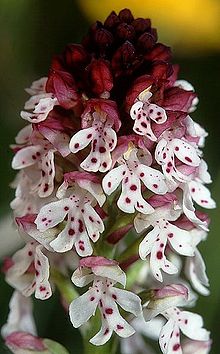Burnt orchid
| Neotinea ustulata | |
|---|---|
 |
|
| Scientific classification | |
| Kingdom: | Plantae |
| (unranked): | Angiosperms |
| (unranked): | Monocots |
| Order: | Asparagales |
| Family: | Orchidaceae |
| Subfamily: | Orchidoideae |
| Tribe: | Orchideae |
| Subtribe: | Orchidinae |
| Genus: | Neotinea |
| Species: | N. ustulata |
| Binomial name | |
|
Neotinea ustulata (L.) R.M.Bateman, Pridgeon & M.W.Chase |
|
| Synonyms | |
|
Orchis ustulata L. |
|
Orchis ustulata L.
Neotinea ustulata (known as burnt orchid or burnt-tip orchid) is a European terrestrial orchid native to mountains in central and southern Europe, growing at up to 2,400 m (7,900 ft) elevation. The plant is considered Endangered in Great Britain and Least Concern internationally based on IUCN Red List criteria. The burnt-tip orchid was voted the county flower of Wiltshire in 2002 following a poll by the wild flora conservation charity Plantlife.
N. ustulata grows from two spherical tubers with thick roots. It is believed that the plant can grow underground for 10-15 years before the first stem appears. Plants have 3 to 9 cm (1.2 to 3.5 in) leaves with prominent veins, along with a couple of leaves typically around the flower stem, which can reach 28 cm (11 in), though typically less than 13 cm (5.1 in) tall.
Flowers are born in a dense cylindrical pattern, with individual plants capable of producing up to 70 flowers. The sepals and petals form a 3 mm (0.12 in) hood that is reddish-brown, over a white crimson-spotted lower lip that is 4 mm (0.16 in). Flowers have a strong fragrance that is described as similar to honey. N. ustulata flowers from May through June, with the subspecies, Neotinea ustulata subsp. aestivalis blooming in July in England. The common name comes from the tips of the flower buds having a burnt appearance.
N. ustulata is distributed throughout central and south Europe, with its main populations in Spain and Greece in the south, reaching England and southern Sweden in the north, and reaching as far east as the Caucasus and Ural mountains. It grows as high as 2,400 m (7,900 ft) elevation in the Carpathian mountains and the Alps. It typically grows on chalky subsoil (occasionally acidic soils) in grassland; fens and open pine forest; mountain meadows, valleys, and ledges; wet grasslands. The plant's largest population in northwest Europe is on Parsonage Down, in Wiltshire, England.
...
Wikipedia
